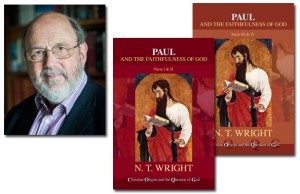Reading Tom Wright’s Paul and the Faithfulness of God (3)
Here’s the third of my series of posts as I read through Tom Wright’s Paul and the Faithfulness of God (= PFG). The earlier posts are here and here. I am enjoying reading it, I must say: as always, Wright writes in an engaging and readable style which makes material accessible and clear.
Chapter 3 is the second of four chapters looking at Paul’s context in the first century: chapter 2 looked at Judaism, this chapter focuses on Greek thought, and the next two focus (respectively) on religion and culture in the Graec0-Roman world, and the Roman imperial setting.
Wright notices early in this chapter that Greek philosophy, especially in Athens, was not merely intellectual navel-gazing (my phrase, not his), as much modern philosophy is perceived: rather, it was about changing the world, both personally and in their city. Here Wright helpfully notes that the major themes of Greek philosophy mean different things to their meanings today: physics is the study of ‘everything that is’, including what we call metaphysics (and thus including the realm of the gods); ethics is how we behave (in the ancient world, closely related to how we see the world); and logic is ‘the whole process of reasoning, dialectic, the way one organised one’s thought in itself and for public presentation. “Logic” was all about making sure that one was moving securely from one point to another, not merely being carried along by rhetoric, emotion, or faulty reasoning’ (p 198).
In particular, for Paul the attack on Athens by Rome in the early 80s BC led to philosophers fleeing, including to Tarsus in Cilicia, where Paul was born. So was Paul a philosopher? Wright criticise the Religionsgeschichtliche Schule (‘History of Religions’ school) for assuming that Paul’s engagement with pagan philosophy implied derivation of Paul’s ideas from that philosophy (such as, classically, in F. C. Baur, or in more recent times, Ed Sanders). Wright makes the preliminary point here that what Paul taught would not have been perceived as ‘religion’ in the ancient world, for it did not involve temples, sacrifices, oracles, priesthood and the like (p. 202)—he will go on to explore this in more detail in the next chapter. More specifically, the early Christians did things which looked much more like philosophy (as understood in antiquity): (i) they argued for a ‘divine reality’ which contradicted the way the world was generally understood; (ii) they argued for and lived a different lifestyle; (iii) they lived their lives in communities which cut across the usual groupings (family, city or region, language, gender, social status) (pp 202-3).
Specifically for Paul, Wright suggests (plausibly, in my view) that during his early post-Damascus Road period (which Wright is happy to call ‘conversion’, p 205), Paul would begin the process of engaging as a Jesus-believer with the philosophers and their thinking. This leads Wright to turn to sketch the major philosophical schools of thought.
Wright identifies four major schools: the Academy (Plato and his successors); the Lyceum (Aristotle and his successors); the Stoics; and the Epicureans. He also notes the Sceptics (sometimes called the Academicians), who were doubtful about the confidence of the other groups, and to some extent, even doubtful about the exercise at all. Wright traces the development of philosophical schools from Socrates, Plato and Aristotle. Socrates was the supreme example of the examined life, a person who lived what he taught. The significance of these key figures is that their thought was current in the first century AD—there had been a revival of study of Plato and Aristotle in the first century BC which ran on into the following century. Wright then focuses on the Epicureans and Stoics, the Epicureans being those who had the luxury of withdrawing from the public sphere in order to reflect (a lifestyle much aspired to today in the West), and the Stoics being the classic pantheists who saw ‘spirit’ as a substance which worked within physical bodies to give coherence and identity. For the Stoics (who, Wright reckons, provided the ‘default’ way of thinking of most whom Paul met) nothing was wrong with the world, for the world was (in some sense) divine. Thus, although Stoics could and did speak of the Graeco-Roman pantheon of gods, at root, Stoicism was essentially monotheistic. Having sketched these four schools (very well, it must be said), Wright then focuses on four key Stoic thinkers in more detail: Seneca, Musonius Rufus, Epictetus, and the Emperor Marcus Aurelius—these four span Paul’s lifetime and into the second century.
Wright then turns to the Cynics and the Sceptics. On the Cynics he says little, referring to his fuller discussion in Jesus and the Victory of God (pp 66-74). On the Sceptics, he notes Cicero’s view (as one such) that there just is not enough evidence to be sure about the divine realm, but (to some extent prefiguring Pascal’s wager) that it was probably wise to continue to worship the gods. Cicero’s On the Nature of the Gods is a classic treatment of views of the gods in the first century, and (with Epictetus) provides evidence that people did talk about such issues at street level as well as in élite salons. Wright notes that Cicero’s own view shows the continuing influence of Plato, and signals that when Paul used terms such as ‘spirit’ or ‘god’, people would assume a Platonic-cum-Stoic view of these terms.
But philosophy was not only theoretical: it was profoundly practical—each of these major traditions taught and lived a lifestyle which went with their convictions or, perhaps better, was the expression of their convictions. These lifestyles had symbols (the texts the studied, the way they dressed and ate), and stories (creation myths, for example). Their answers to the five worldview questions went something like this:
- Who are we? Human beings, belonging to the world, but engaging in enquiry to understand it and live with wisdom in it.
- Where are we? In a world of space-time and physicality, a world which (for some) is also soaked in the divine.
- What’s wrong? People do not understand, and do not learn from philosophy what true happiness is.
- What’s the solution? To study philosophy, naturally! This will clarify and enlighten minds which are darkened.
- What time is it? Here, answers vary more, but generally it’s not a question at home among the philosophers, for many considered that time was cyclical.
Finally, Wright mentions the Second Sophistic movement, which focused on rhetoric as the key and most important activity. Rhetoric became ‘a serious art form in its own right’ (p 237). This presented its own challenges to Paul, as the Corinthian correspondence shows.
Paul’s churches must have looked like philosophical schools to those outside (and perhaps inside too)—here, Wright refers to Luke’s account of Paul in Athens as evidence of the philosophers trying to pigeon-hole Paul.
So how did Jewish people respond to philosophy? Wright chooses here to engage with the Wisdom of Solomon as a text to exemplify this—an interesting choice, rather than (e.g.) Philo or Josephus (to take two other obviously hellenised Jewish writers). Of course, Wisdom is a manageable-sized text, which helps—Philo and Josephus’ writings are voluminous by comparison. The author of Wisdom is asserting that the figure of ‘Wisdom’ functioned in the same way as ‘spirit’ in philosophical thought. Stoic themes and ideas are used, but in the service of a Jewish worldview—thus, the second half of the book retells Israel’s history as the model of how Wisdom acts in the world. Similarities to Paul’s Athens speech are considerable (p 242).
The chapter closes with a very clear and helpful two-page chronological chart of philosophers, organised by their schools, prepared by Wright’s research assistant, Jamie Davies.
This chapter covered material with which I am reasonably familiar, and I personally learned less that was new from it than the earlier chapters. That said, I think it is a very good introduction to the way philosophy functioned and thought and acted in the first century, and demonstrates very good judgement of the most significant figures and issues which are relevant to Paul (at times Wright hints at these links, and I anticipate that the full discussions will come later). I particularly appreciated the way that Wright highlights the pervasiveness of philosophy in antiquity, and also the way that the Jesus movement would not look like ancient religion, but more like philosophy. I recently reviewed Claire Smith’s Pauline Communities as ‘Scholastic Communities’, in which she builds on Edwin Judge’s arguments that the Pauline churches would be seen as ‘learning’ groups, and I can hear her saying ‘Amen!’ at lots of points in this regard. I could see myself recommending this chapter to students as a ’way in’ to this part of the first-century world—it is of sensible compass (pp 197-73).
So next we move on to Graeco-Roman religion: that should be interesting.


